Import content into Uberflip
Content is the backbone of any content experience (no content, no experience). In Uberflip, you can pull content in from several sources. This gives you the ability to then curate and distribute that content as personalized experiences for any audience.
After you've connected a content source, that source remains connected to Uberflip. This means that when content is added or updated at the source, it's also added/updated in your Uberflip account!
This article shows you how to connect content sources to Uberflip, so you can import your digital marketing assets.
Note
Want to create blog posts from scratch in Uberflip? Check out: Create a Blog Stream
Before you begin
- You must be an Account Admin or Content Manager to import content into Uberflip
What can I import?
There are 7 content sources you can import from with Uberflip:
- Blogs (using an RSS feed)
- Flipbook folders (for Flipbooks and PDFs)
- Vidyard
- Wistia
- YouTube
- Vimeo
- Brightcove
SlideShare Streams have been retired
The ability to create new SlideShare Streams has ended. Check out SlideShare Streams are being retired [Nov. 2023] for details.
Import content into Uberflip
The process for importing content from each source is a bit different, but it always begins the same way. So let’s start there:
- In the Hub you want to add content to, head to the Content page if you’re not already there (found in the sidebar navigation)
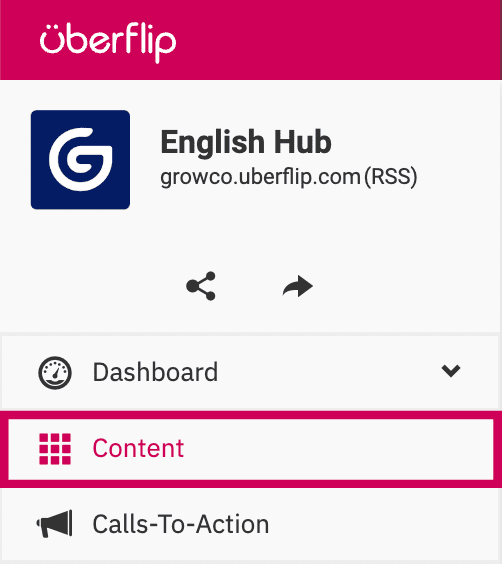
- Click New Stream (in the Streams tab)

- Choose the content source you want to import from in the Source Streams list
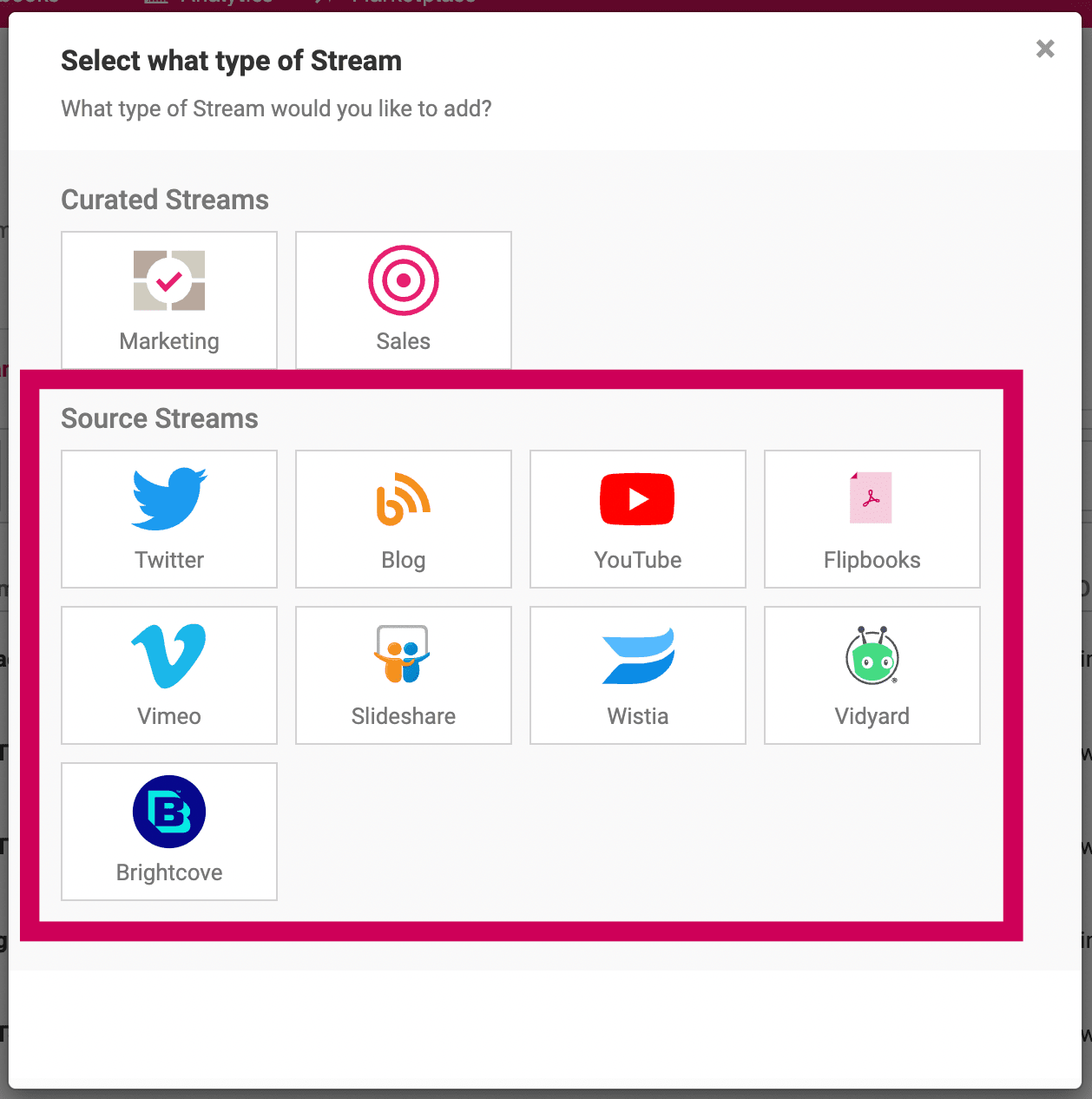
- A modal screen specific to the content type you’ve selected will open
From here, the process changes for each content source. Expand the section for your chosen content source below to continue:
Before you begin: Prepare your external blog for importing into Uberflip
Default RSS settings are often not configured to include all articles, or may not include images.
To get the best results when importing external blog content, we recommend optimizing the RSS feed settings before creating the Blog Stream in Uberflip.
After the RSS feed is optimized, use the steps below to import it into Uberflip:
- In the first text field, enter the URL for your external blog's RSS feed
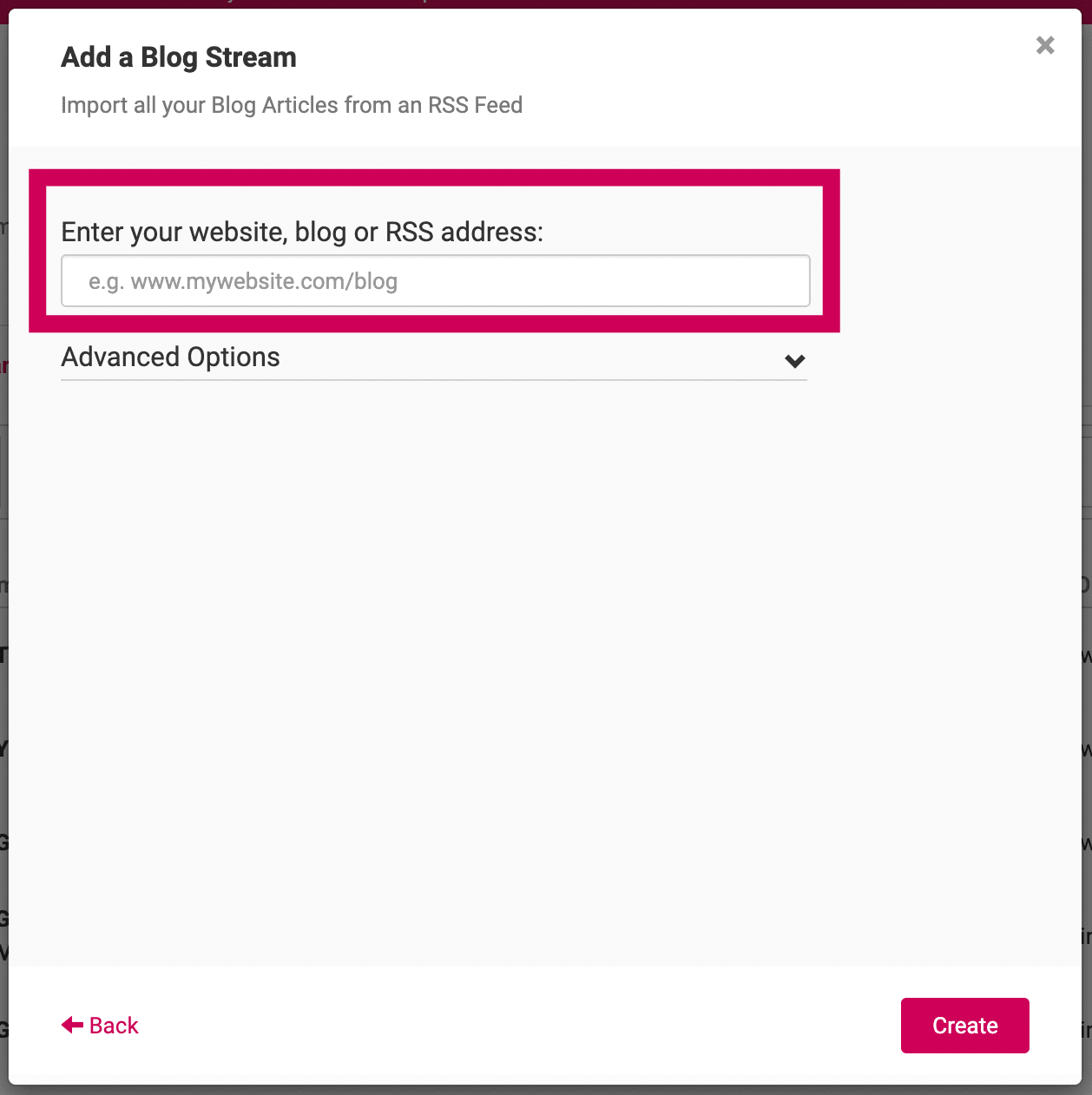
- In the Advanced Options section, you can configure various options for this Blog Stream by checking the applicable boxes. See below for more information about the available options.
- By default, all options are disabled (unchecked). You don't need to enable any of these options to proceed.
- The Start from scratch option allows you to create an empty Blog Stream, rather than importing content. See below for more information.
- Click Create
- Uberflip will begin importing posts from your blog. When it's done, you'll see a confirmation message. To view the Items that were imported, click View Stream.
That's it! Your blog content has been imported into your Hub. And all new posts added to that RSS feed in the future will be imported automatically.
Blog Stream Options
When you create a new Blog Stream that imports content from an external blog, you can enable various options. Here's what each option does:
- Start from scratch: Enable this option to create a new, empty Blog Stream that you can post to from within Uberflip. See below for more instructions. Enabling this option automatically disables all the options below.
- Allow small images to be used for thumbnails: By default, images must be at least 180 px x 100 px to be used as thumbnail images for Items (posts) in a Blog Stream. If your thumbnails are smaller than this, you can enable this option to use them anyway.
- Automatically match author profiles: If the authors of the content on the external blog also exist as authors in Uberflip, enabling this option will match the appropriate Uberflip author profiles to the imported content.
- Allow class attributes, style and font tags to be imported: By default, Uberflip strips out CSS class attributes and other tags when importing external content. Enable this option to keep these elements intact in the content after import. Note that any referenced classes, fonts, etc. must be defined in your Hub's Custom Code for the corresponding formatting to be retained.
- Automatically create and apply tags from RSS to items: Enable this option to automatically create Uberflip tags from any tags contained in the RSS feed.
In Uberflip, Flipbooks Streams can be made from Flipbook folders.
If you already have a Flipbook folder ready to be turned into a Stream, select it from the dropdown in the Add a Flipbooks Stream modal. Then click Import.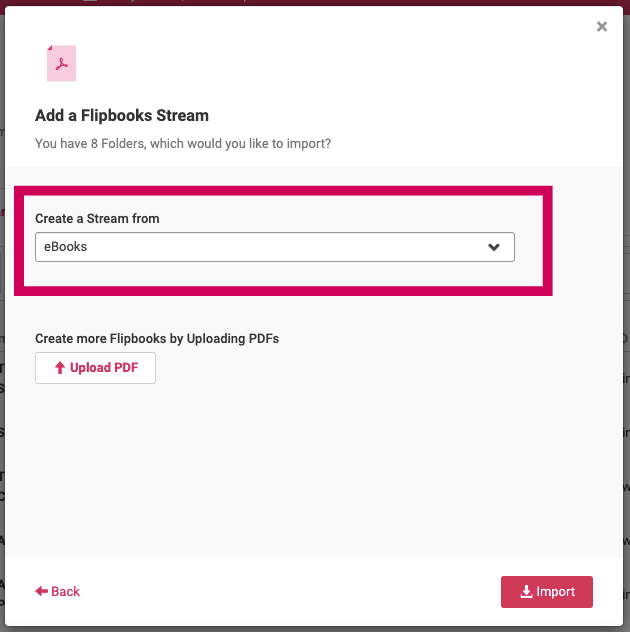
If you want to upload a new PDF, you can do so with the steps below:
- In the content modal, click Upload PDF
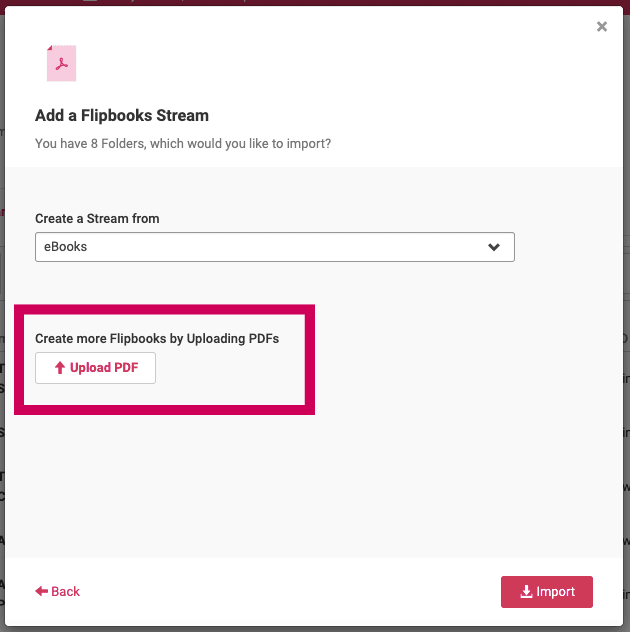
- The Create new Flipbook window will appear, where you will be on the Choose File page
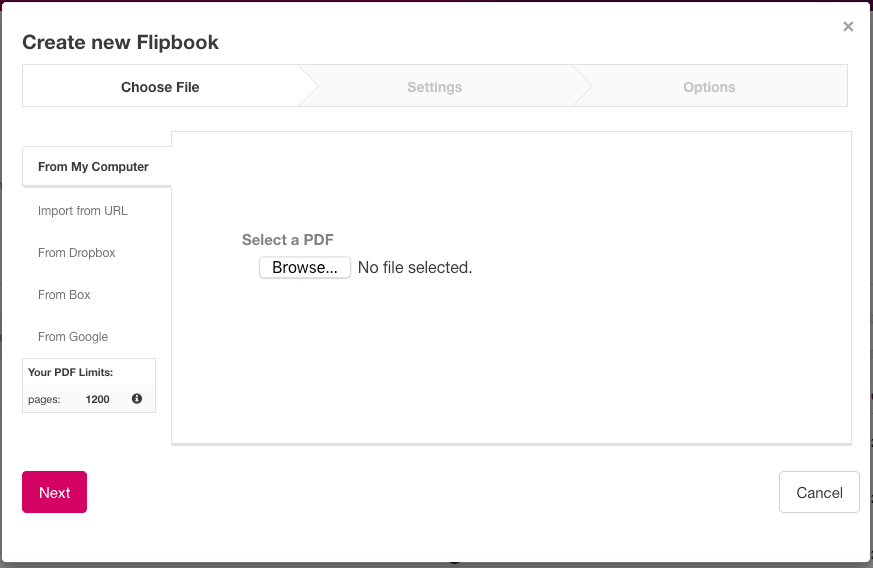
- Use the tabs on the left to choose your upload method. You can use any of the following methods to upload your PDF:
- From My Computer: Use this option if you have the PDF file stored on your computer.
- Import from URL: If your PDF file is stored on a web server where it is directly accessible using a link, use this option to paste in the link. Note that FTP is not supported. To upload files via FTP, see this article.
- From Dropbox/Box/Google Drive: Choose one of these options to connect a cloud storage account where the file is stored. When using one of these methods, you can choose to upload multiple PDFs at once.
- When you've selected your PDF file, click Next
- Now on the Settings page:
- Choose a folder for your Flipbook. Your flipbook will be kept in this folder, and will be added to any Stream created from this folder. All folder settings will apply to this Flipbook.
- Name your Flipbook in the field provided (this will be pre-populated using the filename of the PDF)
- Under When your should your Flipbook publish/activate, choose whether you want it to become available immediately after it is uploaded, or choose a specific date and time on which to publish it instead
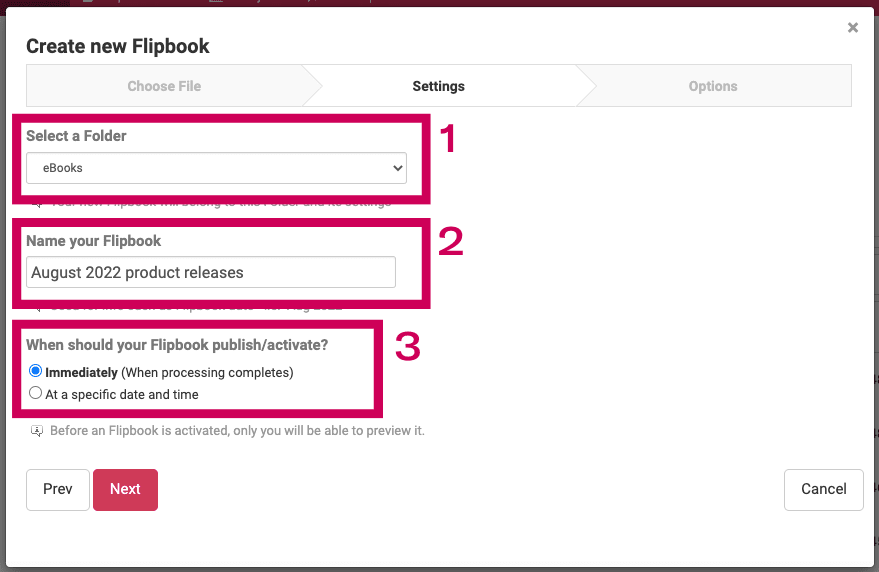
- Click Next when you're ready to proceed
- Now on the Options page, choose whether you want to run an Auto-Link job on your new Flipbook
- See this article to learn about the Auto-Link tool.
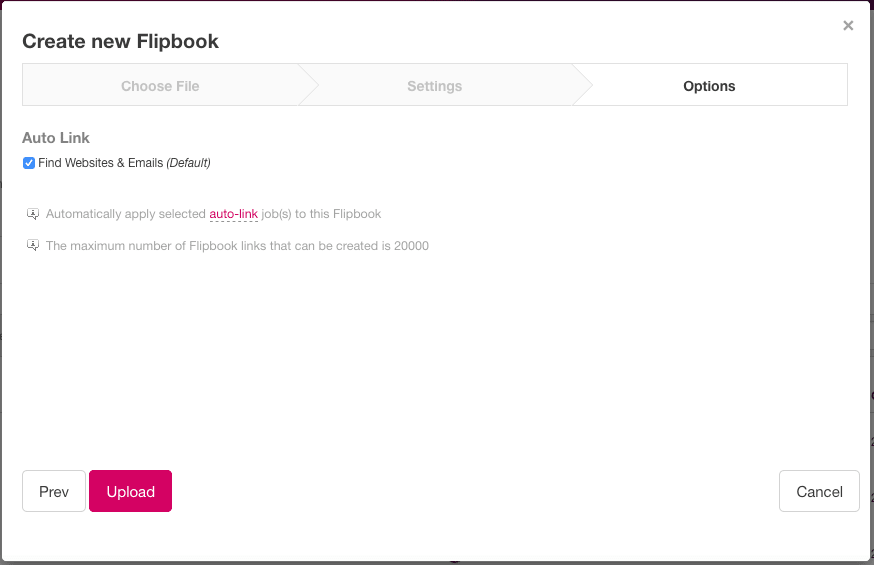
- See this article to learn about the Auto-Link tool.
- Click Upload
After uploading, you'll be returned to the Manage Folder view. You'll see the new Flipbook listed here, where it will initially be shown as being in processing. Depending on the size of the PDF, this may take a few minutes.
When the Flipbook is published, it'll be added to any Stream created from that Flipbook folder.
Tip
Want to start editing your Flipbook right away? From the Manage Folder page, Click on the PDF. Then click Load in Page Editor (found under Flipbook options).
Check out Get started with the Flipbook Page Editor to learn about editing Flipbooks.
- You'll now see the Add a Vidyard Stream screen. Paste your Vidyard API token into the field provided.
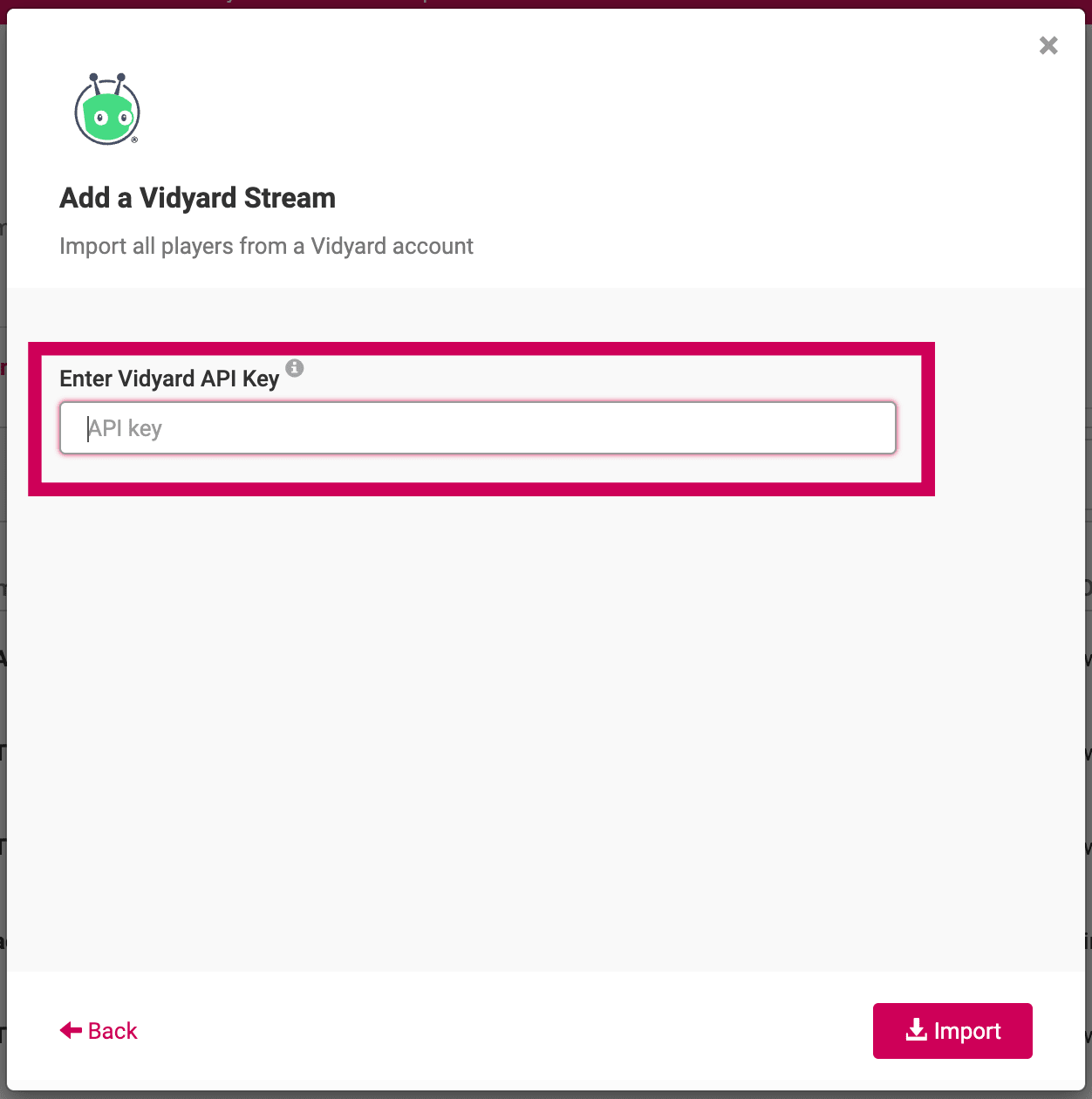
- Click Import
- Uberflip will begin importing players from the Vidyard account associated with that token. When it's done, you'll see a confirmation message. To view the Items that were created for these players, click View Stream
That's it! Your Vidyard content has been imported into your Hub, and is now available to be included in the content experiences you create.
Tip
Does your Vidyard account contain a lot of players? By default, Vidyard Streams will pull in a maximum of 50 players. If you need to import more than that, please contact Uberflip Support for help.
First time connecting to Wistia:
Click the Connect button. A login or authorization window will appear. Follow the steps to connect your Wistia account to Uberflip.
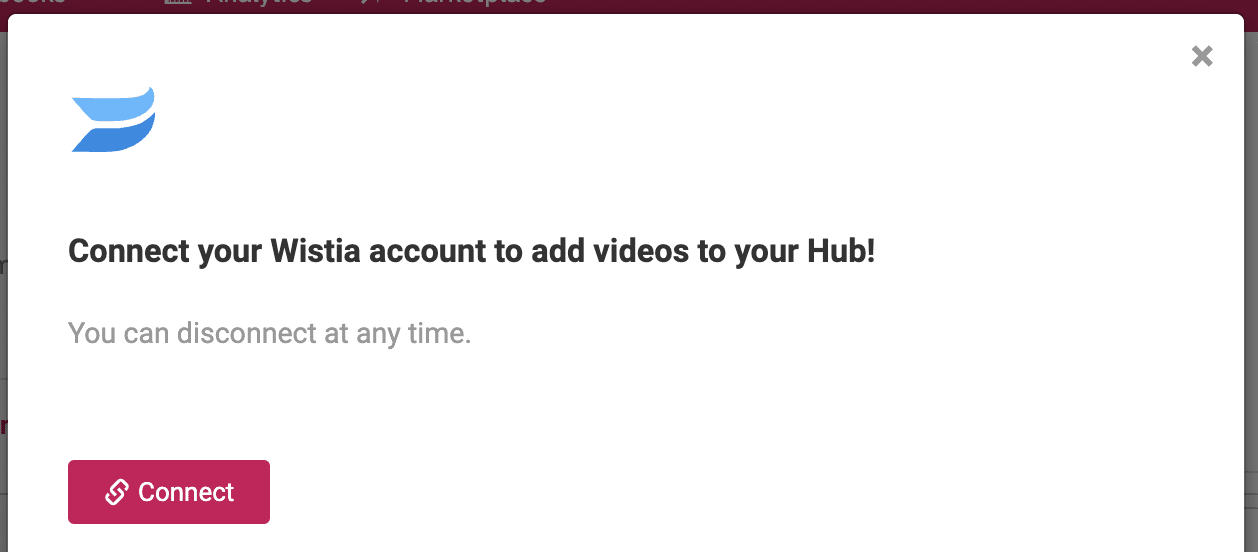
When done, the browser window will close automatically, and you'll be returned to the Content section of Uberflip, with a message that Wistia was successfully connected. You're ready to create your Wistia Streams.
When Wistia is connected:
- In the Streams tab of the Content page, click New Stream

- Select Wista again in the Source Streams list
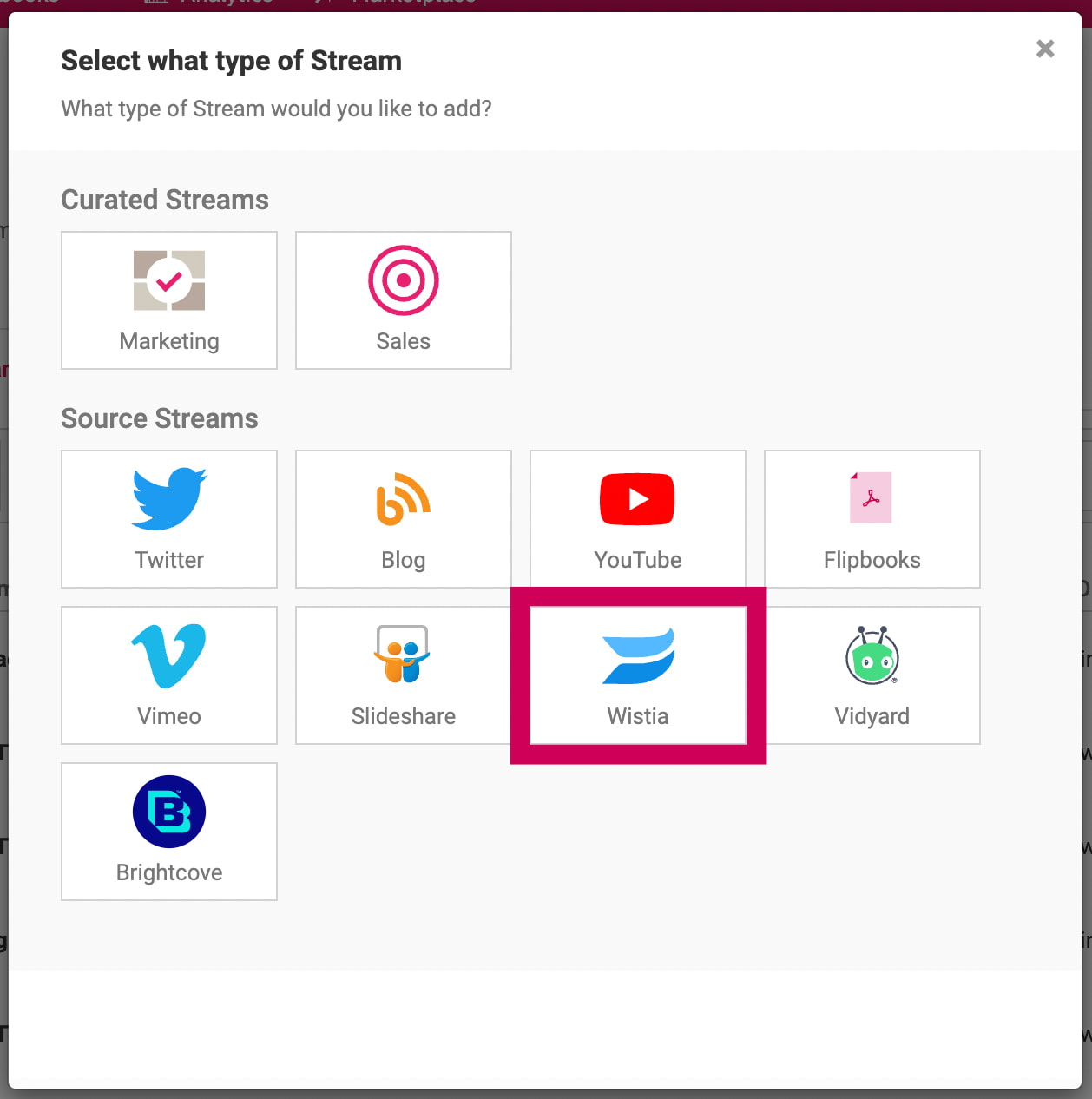
- The Add a Wistia Stream modal will open
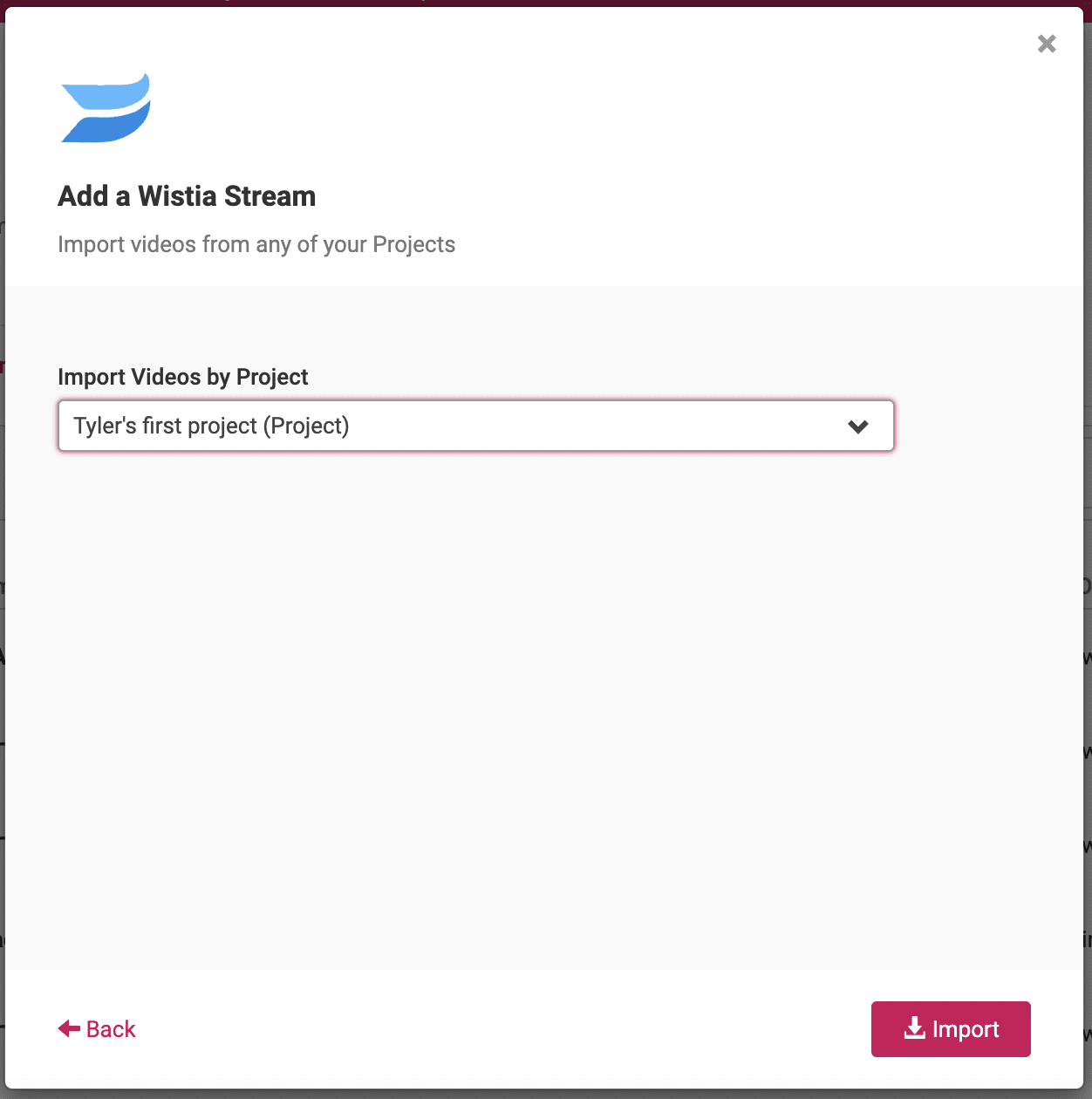
- Under Import Videos by Project, click the dropdown box and select the project you want to import videos from into this Stream.
- Uberflip will begin importing videos from the selected project (up to 100 most recent). When it's done, you'll see a confirmation message that shows the number of videos that were imported.
To view the content Items that were created for these players, click on the View Stream button
That's it! Content from the selected Wistia project has been imported into your Hub, and is now available to be included in your content experiences. New videos uploaded to the connected project will be imported automatically.
If you want to bring in content from other projects, simply create additional Wistia Streams.
First time importing videos from YouTube:
You'll see a Connect button in the content modal. Clicking this will open a Google account login window. Login as you normally would to connect to YouTube.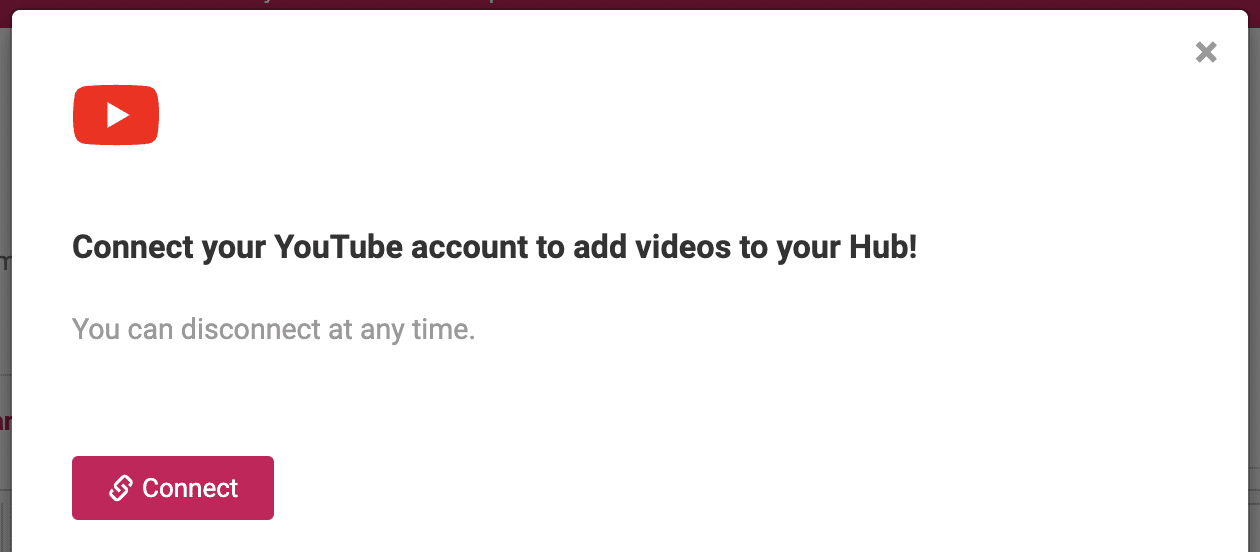
After you've successfully logged in, you'll see a success message and be brought back to the Content page.
When YouTube is connected:
- In the Streams tab of the Content page, click the New Stream button

- In the modal that opens, click YouTube in the Source Streams list
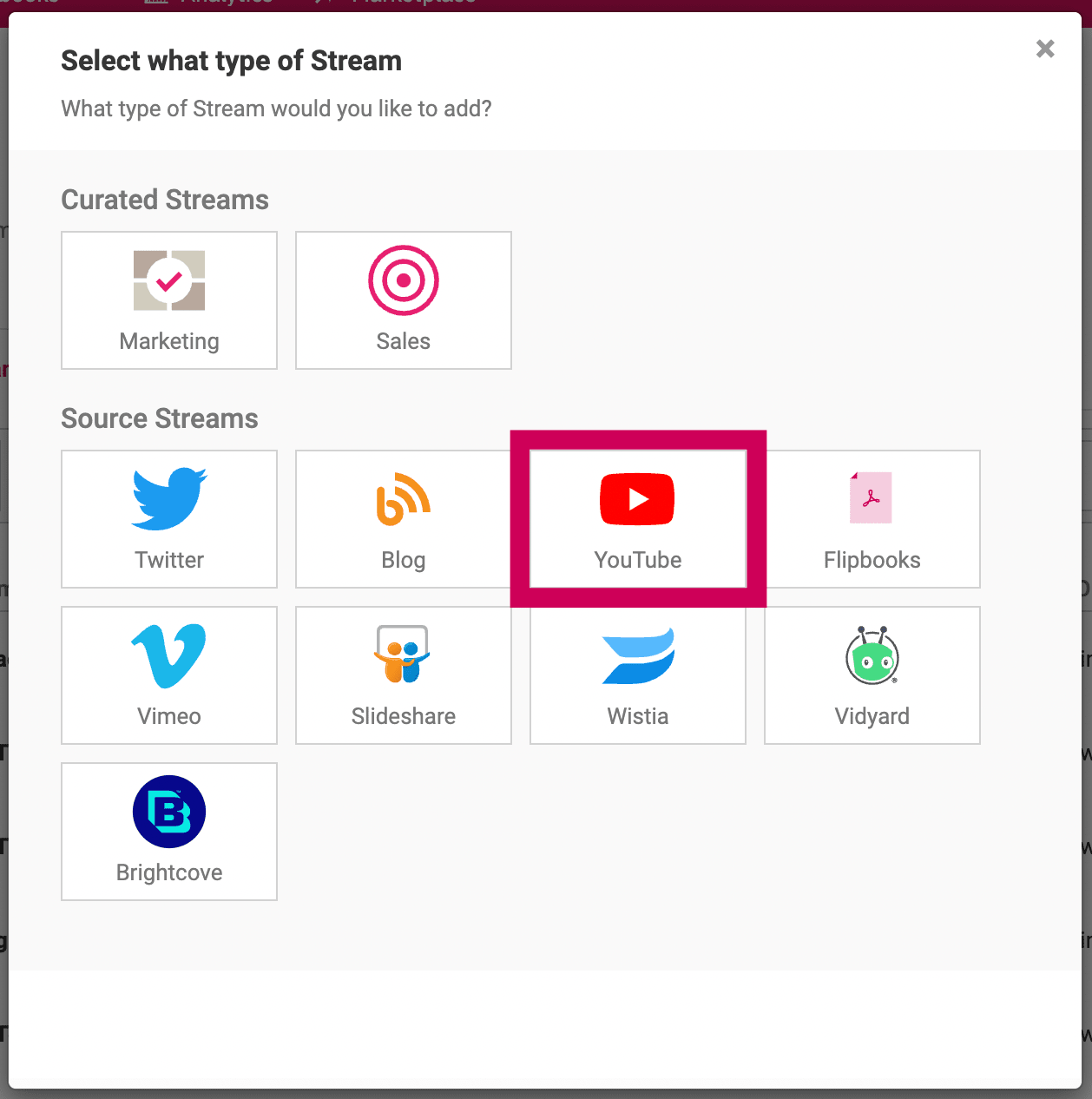
- The Add a YouTube Stream modal will open
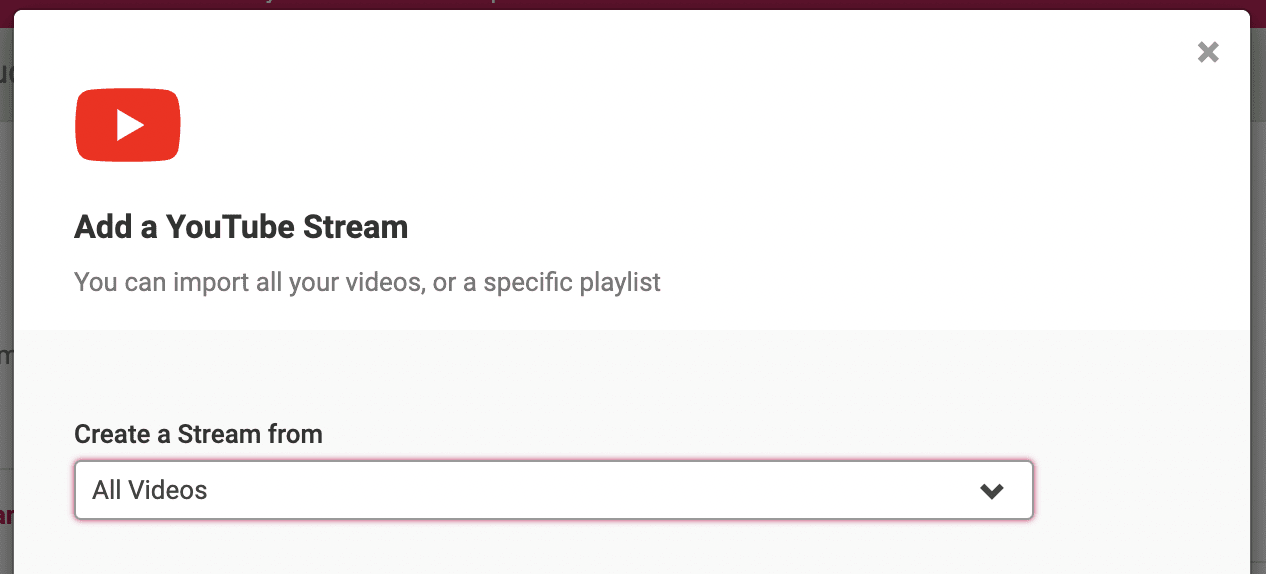
- Click on the dropdown box, and choose what you want to import:
Note
You can import public and unlisted videos (including live streams), but not private videos.
- Import all your videos: Select the All Videos option to import all videos from the connected YouTube channel
- Import a playlist: Select a playlist from the list of playlists in the connected YouTube channel to import just the videos from that playlist
- Once you have selected an option, Uberflip will begin importing videos. When this is done, you'll see a confirmation message that shows the number of videos that were imported.
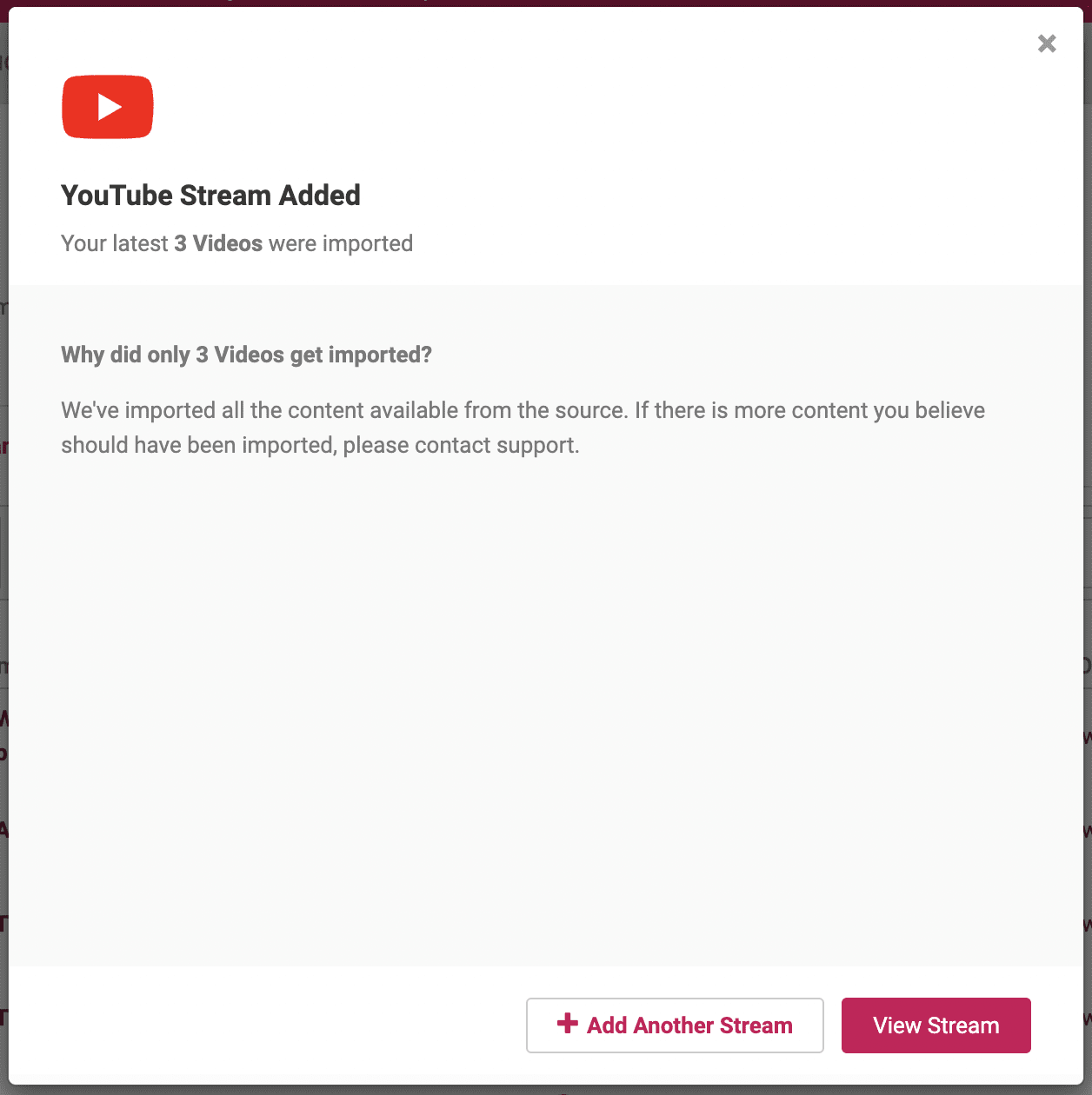
- To view the content Items that were created for these videos, click on the View Stream button
That's it! Your YouTube videos have been imported into your Hub, and are now available to be included in the content experiences you create.
The YouTube Stream you create will remain connected to either the channel or the playlist you chose, and will continue to pull in any new content you publish there automatically.
First time connecting to Vimeo:
If it's your first time connecting your Vimeo account, use these steps to connect.
- Click the Connect button
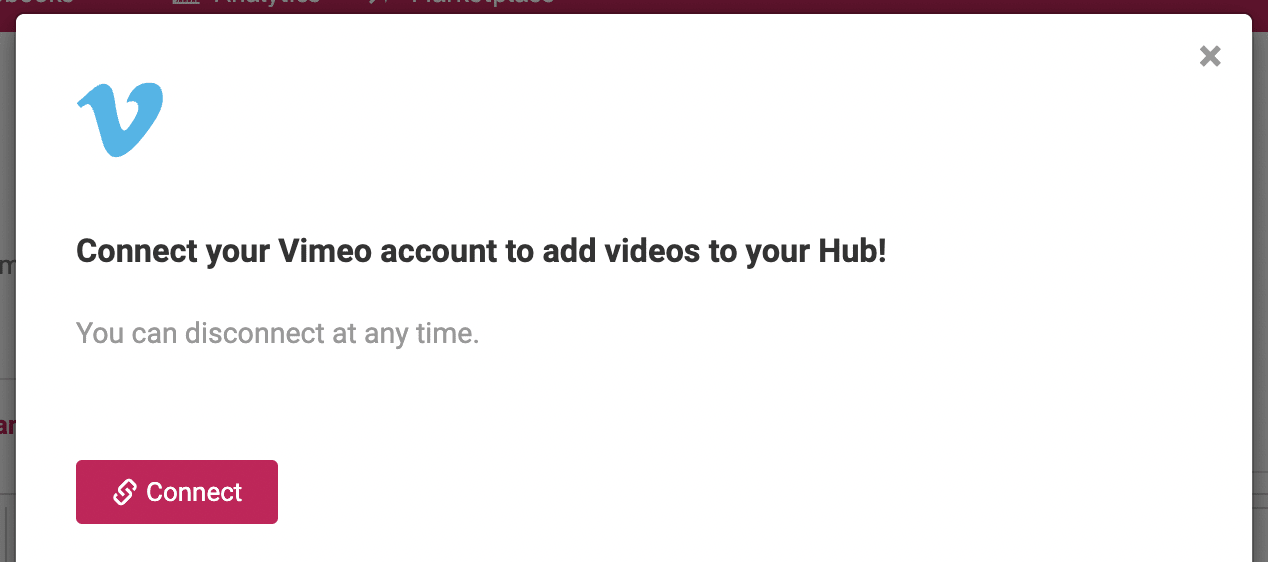
- A Vimeo login page will open. Log in to the Vimeo account you want to connect using any of the available options
- If you're already logged in to Vimeo you won't see this screen, so skip ahead to the next step. Make sure you're logged in to the account you want to connect to Uberflip!
- In the Vimeo Authorize screen that appears, click Allow to confirm that you want to give Uberflip access your Vimeo account
When Vimeo is connected:
- In the Streams tab of the Content page, click New Stream

- Click Vimeo again in the Source Streams list
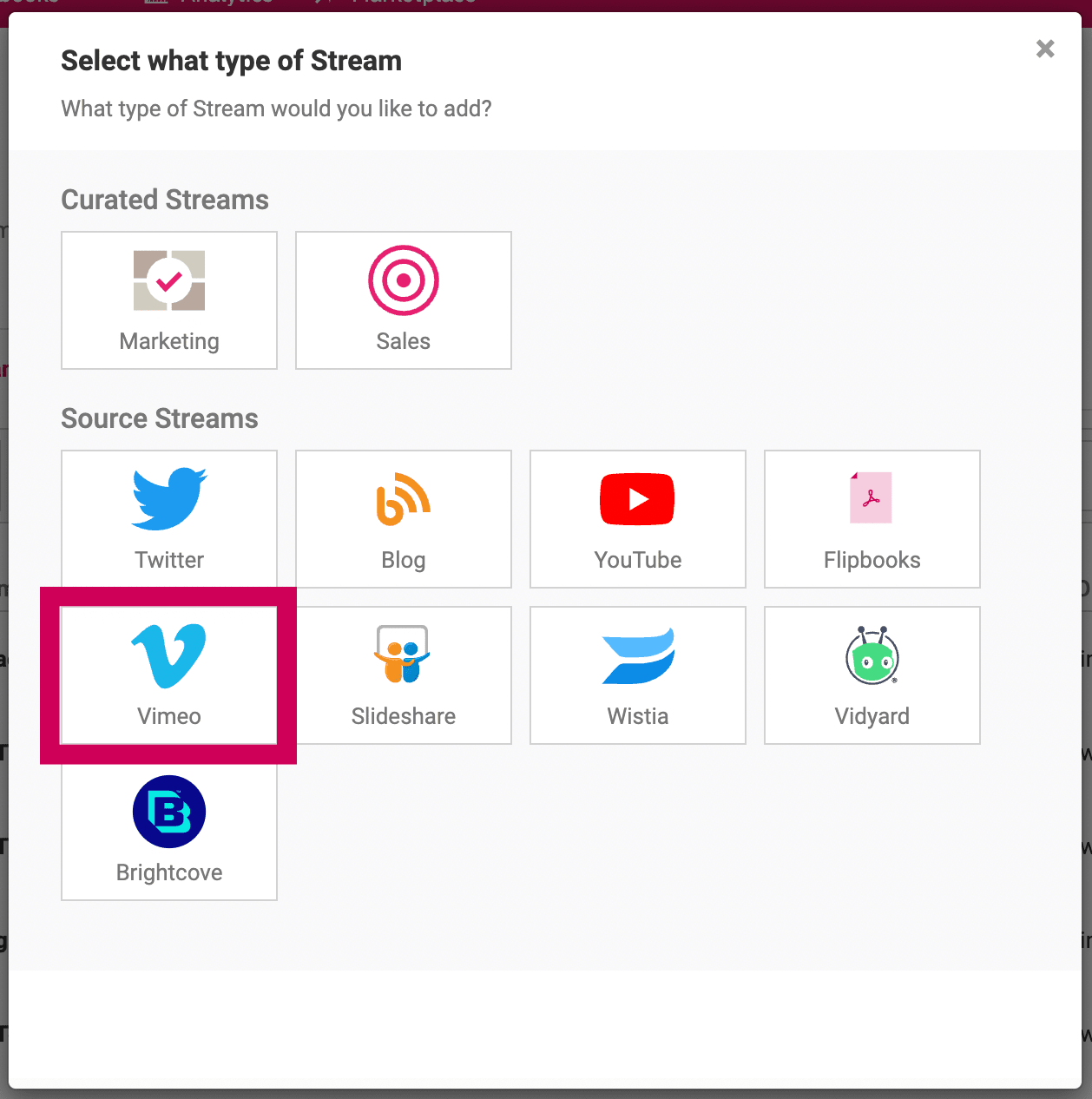
- Because your Vimeo account is already connected, you'll now see the Add a Vimeo Stream screen
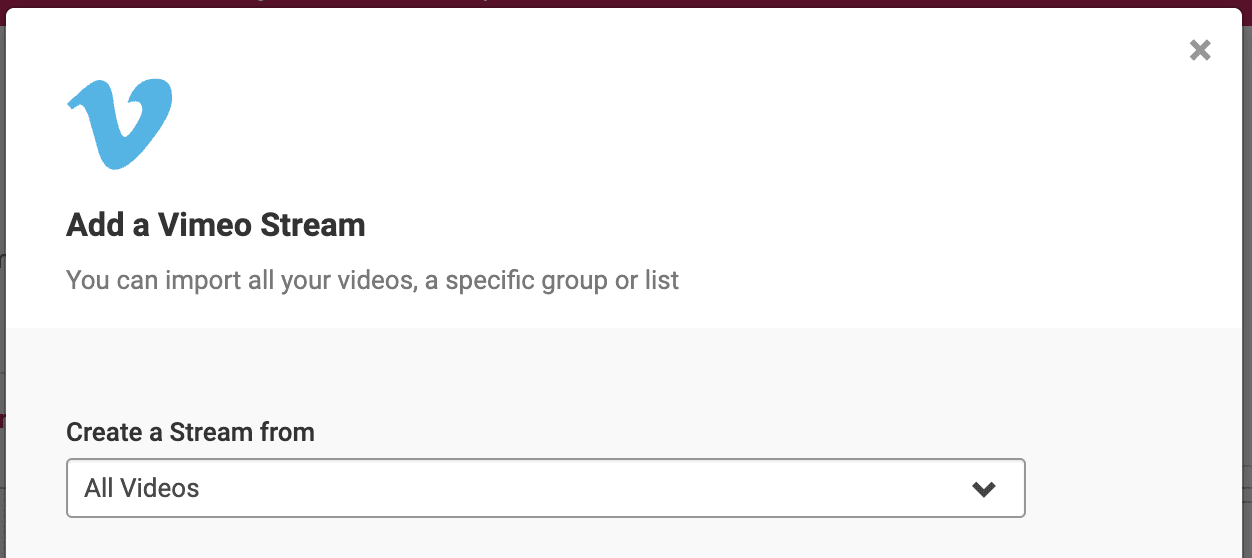
- Under Create a Stream from, click the dropdown and choose what you want to import from your account
- Click Import
- Uberflip will begin importing videos. When this is done, you'll see a confirmation message that shows the number of videos that were imported. To view the content Items that were created for these videos, click View Stream.
That's it! Your Vimeo videos have been imported into your Hub, and are now available to be included in the content experiences you create.
- In the Add a Brightcove Stream screen that appears, paste in the Account Number, Client ID, and Client Secret that you copied from Brightcove into the fields provided
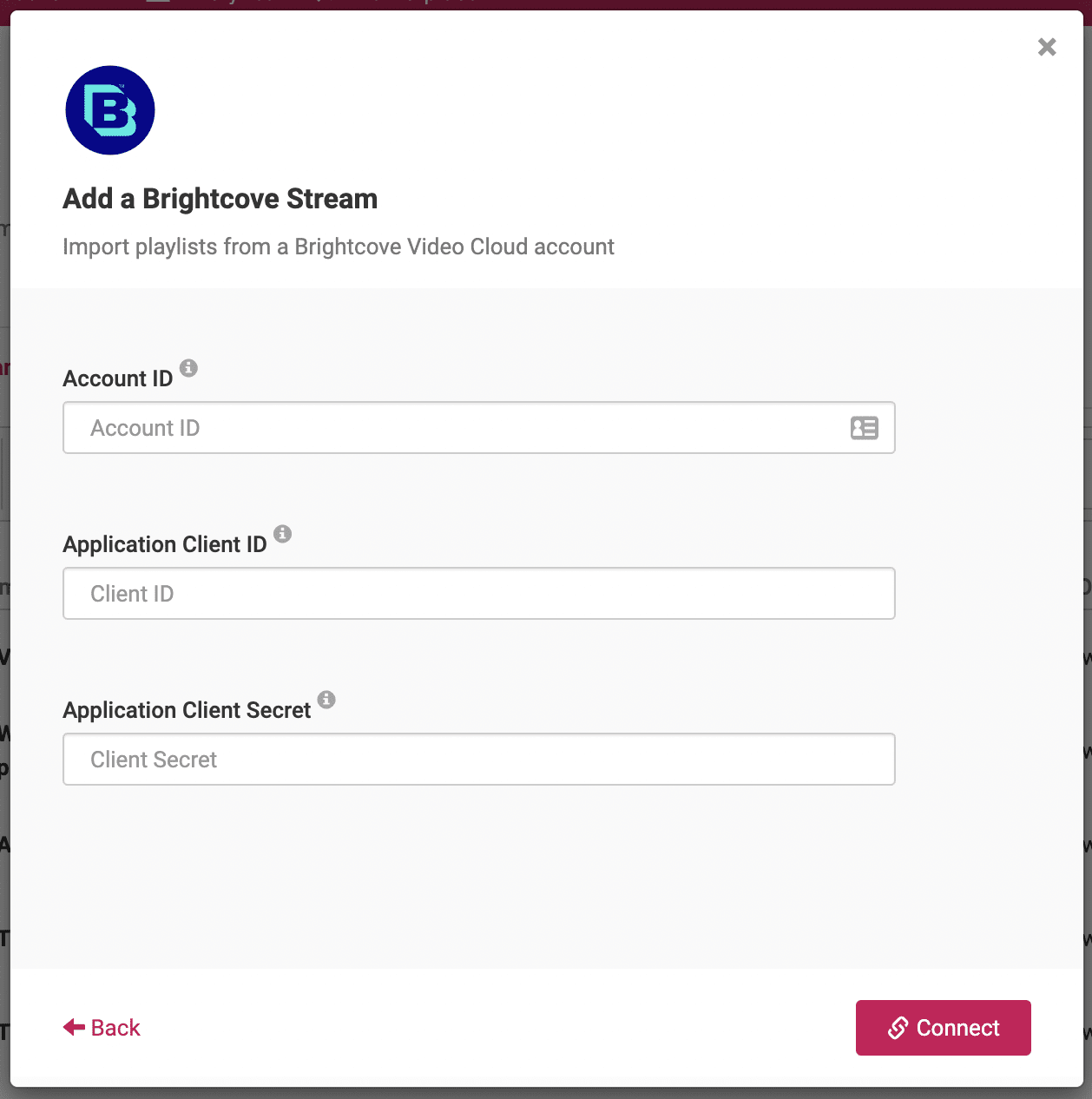
- Click Connect when you're ready
- Click the Select a Player dropdown to choose the player that contains the videos you want to import
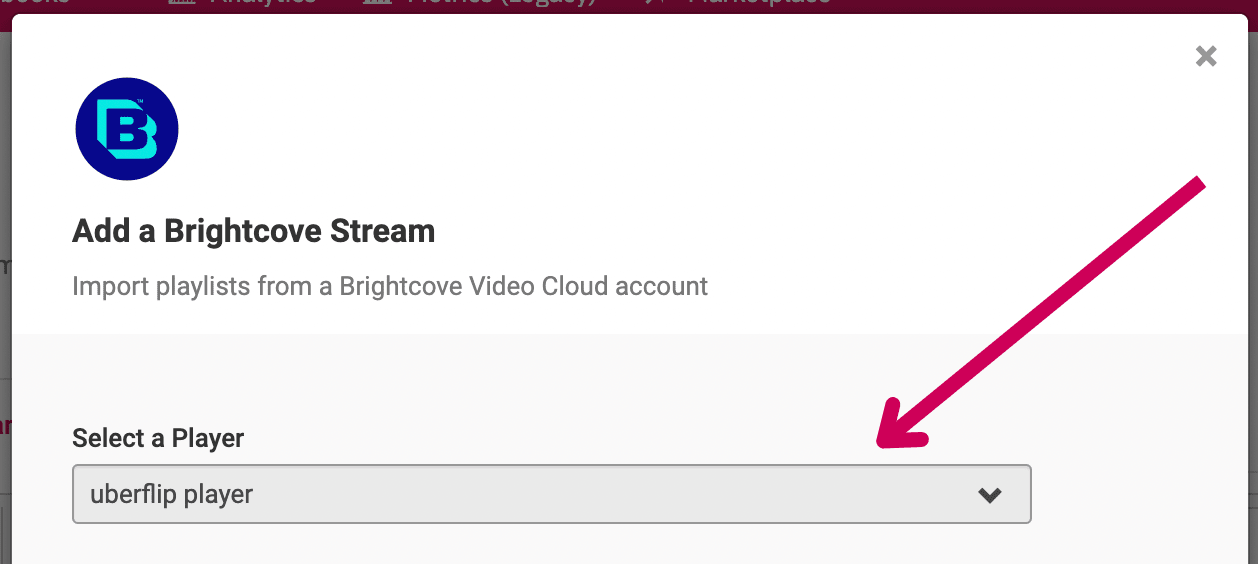
- After you've select a player, the Import a Playlist dropdown will appear. Click the dropdown and select the playlist you want to import videos from
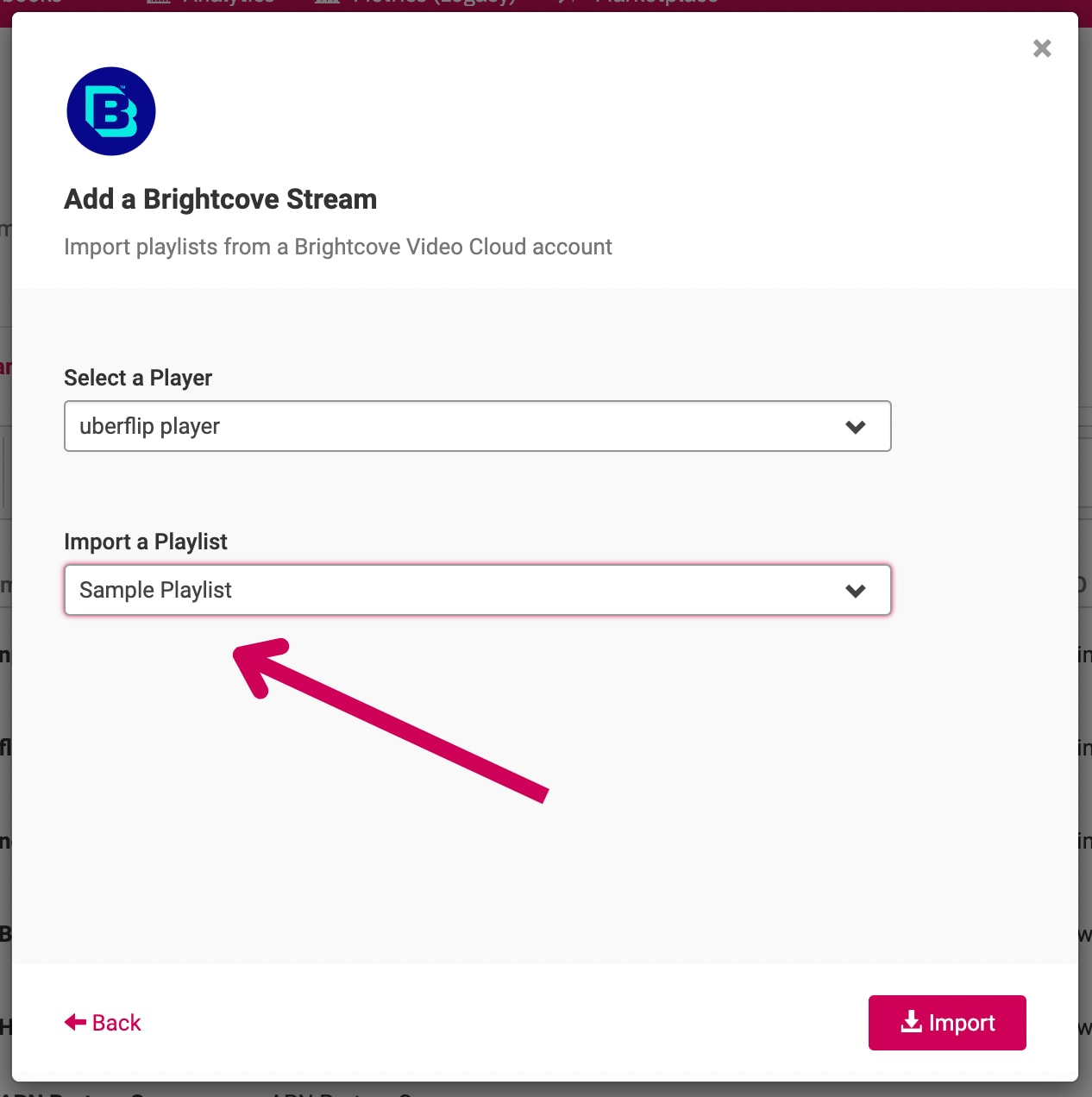
- Uberflip will begin importing videos from the Brightcove account(s) associated with the client you used. When it's done, you'll see a confirmation message that shows the number of videos that were imported.
To view the content Items that were created for these players, click View Stream.
That's it! Your Brightcove content has been imported into your Hub, and is now available to use in your content experiences. The Stream will remain connected to your Brightcove playlist, and will pull in new content you publish there automatically.
Each Brightcove Stream you create pulls videos from one playlist in one Brightcove player. You can import videos from multiple Brightcove playlists by creating multiple Brightcove Streams.
Remember, Once you've connected a content source, that source remains connected to Uberflip. When content is added or updated at the source, it'll also be added/updated in your Uberflip account.